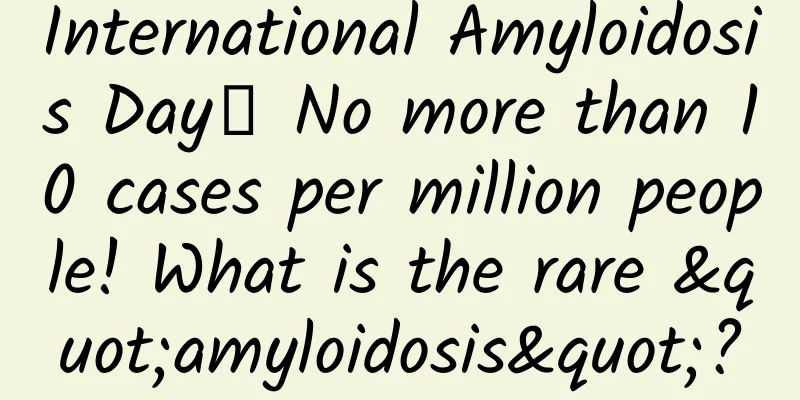International Amyloidosis Day│ No more than 10 cases per million people! What is the rare "amyloidosis"?

|
Systemic light chain (AL) amyloidosis is a rare disease, with an incidence of 8 to 10 cases per million person-years reported in Europe and the United States. There is no exact incidence data in my country. Its clinical manifestations are diverse, and diagnosis and treatment are difficult. The median survival of patients with severe heart involvement is less than 1 year, and patients have a heavy disease burden. October 26 is International Amyloidosis Day. On this occasion, CCMTV is honored to invite Mr. Huang Rufang from the Code Rare Disease Center, Professor Lu Jin from Peking University People's Hospital, and Professor Liu Peng from Zhongshan Hospital Affiliated to Fudan University to talk about their feelings and experiences around the current status and treatment prospects of AL amyloidosis, to speak for rare diseases and make them visible. At the beginning of the interview, Mr. Huang Rufang, Professor Lu Jin and Professor Liu Peng gave words of encouragement to AL patients and cheered them up. Raising the visibility of rare diseases and expecting new treatments to become more widely available Q1: In recent years, you have been committed to making "rare diseases visible". What do you think is the current level of society's awareness of rare diseases? Rare diseases are special and have a small patient population, so society pays relatively little attention to them. But in the past decade, with the call of the whole society and the attention of the government, rare diseases have gradually become known to more people. I have also done a lot of publicity and promotion work in this industry. It can be said that rare diseases have gradually become widely known from being little known more than a decade ago. Q2: What do you think is the significance of innovative drugs in the treatment of rare diseases in my country? How can we further improve the accessibility of drugs for rare diseases? In fact, most patients with rare diseases do not have many specific treatment drugs, which is the biggest challenge we are facing. Among the innovative drugs being developed globally, more and more are focused on the field of rare diseases. We hope that these innovative drugs can enter China as soon as possible to treat Chinese patients with rare diseases and improve their accessibility and affordability of treatment. Q3: Currently, less than 10% of rare diseases in the world have treatment methods and plans. What do you think about the treatment prospects of patients with rare diseases? Currently, more than 90% of patients with rare diseases have no available medicines. However, with the development of new technologies, the efforts of the biopharmaceutical industry, the research of scientists, and the attention of various countries to the protection of the rights and interests of patients with rare diseases, I believe that patients with rare diseases will have more options and better treatment possibilities. At the same time, advanced therapeutic technologies such as cell gene therapy and nucleic acid technology are constantly developing. I believe that in the future, patients with rare diseases will have hope of cure. Even though it is difficult to diagnose and treat, there is always hope for new treatments. Q1: You are deeply involved in the field of blood. AL amyloidosis is a malignant tumor with abnormal proliferation of plasma cells. What are the main clinical manifestations? What are the key points and difficulties of diagnosis? The clinical manifestations of amyloidosis vary and can affect multiple organs. For example, the heart and kidneys are most commonly affected. Patients with heart disease may experience fatigue and heart failure. Kidney involvement may cause foam in the urine, increased protein in the urine, and edema in the lower limbs or face. In addition to the two main affected organs, the kidneys and the heart, other organs, including the gastrointestinal tract, liver, autonomic nervous system, blood system, and even the skin and muscles may be affected. Patients may experience symptoms such as enlargement of the submandibular gland, parotid gland, and sublingual gland, as well as lung involvement. It can be said that primary systemic amyloidosis can be seen in any department of a general hospital except pediatrics. The difficulty in diagnosing AL amyloidosis is that the symptoms are atypical, so doctors need to be aware of the disease in order to think of and diagnose it. This requires not only the efforts of the hematology department, but also the doctors in other departments of the general hospital, including cardiology, nephrology, gastroenterology, and even surgeons should be able to think of this disease in order to achieve early diagnosis and avoid delays. I think the main problem is the delay in diagnosis caused by atypical symptoms. Q2: In the past, treatment options for patients with AL amyloidosis were limited. The emergence of innovative drugs and new treatments has provided patients with more treatment options. Can you talk about some of the current progress? With the progress of overall treatment of plasma cell diseases, amyloidosis has also made great progress in this regard. The main progress currently includes the following aspects: The first is CD38 monoclonal antibody, including daratumumab and its subcutaneous injection preparation, which have been launched in China. It is worth mentioning that for patients with a heavy heart burden, subcutaneous injection preparations have less volume load problems and a lower incidence of adverse events related to infusion, making them more suitable for patients with severe heart involvement. Another CD38 monoclonal antibody, isatuximab, has been proven to be effective in amyloidosis and will be launched in China next year. The second is BCMA monoclonal antibody. Currently, an ADC drug abroad has shown effectiveness. This drug is expected to be launched in China next year, providing a new treatment method for the BCMA target. The third is BCMA dual antibody. Small sample data show that it has a 100% efficacy against amyloidosis, especially for patients with refractory relapse. For such patients, we may have another treatment option in the future. The fourth is BCMA CAR-T therapy, which has also been shown to have an efficacy of approximately 100% in refractory recurrent amyloidosis. In addition, there are small molecule targeted inhibitors. We know that about 40% to 50% of patients with amyloidosis have t(11;14), so Bcl-2 inhibitors, including venetoclax and BGB-11417, have also shown efficacy in amyloidosis. Therefore, the treatment of amyloidosis has made great progress compared with before. Q3: Can you share the treatment goals for patients with AL amyloidosis? What are your prospects for the future of patients with AL amyloidosis? I think the minimum goal is to at least achieve VGPR, which is a very good partial response. The standard is the difference in serum free light chains, that is, the difference between the affected light chains and the unaffected light chains is within 40, which is our minimum standard. If we want to achieve a better response, we may also have complete response, strict complete response, and residual negative response. These deeper responses may bring better survival to patients. Pay attention to home disease management and be alert to changes in the disease Q1: Home disease management is an important part of the overall management of patients with AL amyloidosis. Can you talk about what aspects of home disease management for patients with AL amyloidosis are included? With the continuous emergence of innovative drugs and improved patient accessibility, the quality of life, remission rate and long-term survival of patients with amyloidosis, a disease with a very high mortality rate in the past, have improved. In addition to receiving treatment in the hospital, patients spend most of their time receiving treatment and resting at home. Home management is an important part of the entire treatment process. I think patients and their families should pay attention to the following points: First, it is very important to take medication regularly. Some oral medications need to be taken at home. The interval and dosage of medication are very important. Patients should keep a clear record of the time and dosage of each medication. If the dosage or interval is not appropriate, it may affect the efficacy and even cause serious side effects. Secondly, patients should closely monitor their condition. At home, patients should monitor their blood pressure, edema, fatigue and other symptoms. These symptoms may be related to changes in the disease and should be treated in a timely manner. Third, patients should visit the hospital for follow-up visits regularly as recommended by their doctor. This may be done once a week at the beginning of treatment, then every two weeks or once a month. Even after the main treatment is over, it is recommended that patients visit the hospital for follow-up visits once a month or every two months. Fourth, patients should pay attention to nutrition and rest. Regular diet and rest are essential for recovery. At the same time, patients should actively seek support from their families and society. Returning to work and social activities is very important for disease recovery and psychological support. Finally, patients should pay attention to the latest changes in disease treatment methods and drugs, and the continuous emergence of new drugs. If patients can understand this information in a timely manner, they can receive new treatments in a timely manner if their condition changes in the future. Q2: Many family members do not know much about the distinction between λ type and κ type and the efficacy evaluation indicators. Can you explain the indicators for efficacy evaluation and how patients can understand their own classification? AL amyloidosis is caused by the deposition of structurally altered immunoglobulin light chains on target organs. Depending on the type of light chain involved, it can be divided into λ and κ types. There are two main aspects of efficacy evaluation: on the one hand, hematological remission, that is, the clearance of circulating malignant tumor cells; on the other hand, organ remission, that is, the recovery of organ function such as the heart and kidneys. The detailed indicators are not described here. In terms of hematology, we mainly focus on the clearance of free light chains. Complete clearance of free light chains is definitely the most ideal state, and partial clearance and most clearance are also what we strive for. The relief of cardiac function mainly depends on the reduction of soluble myocardial marker brain natriuretic peptide in the circulation, and the relief of kidney function mainly depends on the urine protein. The relief of liver function mainly depends on liver volume and alkaline phosphatase levels. Different organs have different evaluation indicators. Patients should communicate with their doctors, understand these indicators, and adjust the treatment plan according to the doctor's advice. Q3: What are the key points of home disease management for patients with AL amyloidosis? Can you share your suggestions for standardized management? What good methods can help patients further improve their awareness of home management and follow-up in the future? In addition to the points mentioned above, I think there are a few more issues that need attention. First, because the clinical manifestations of light-chain amyloidosis are atypical, other diseases may also have similar manifestations. Therefore, at home, family members or patients themselves should be vigilant when observing changes in the condition and recognize the complexity and variability of the clinical manifestations of the disease. For example, if you suddenly feel weak recently, especially after getting up in the morning, or have symptoms such as edema of the limbs, difficulty breathing, and unexplained weight loss, we should consider whether the condition has changed. Early detection of changes in the condition is crucial for timely treatment and a good prognosis. This is what makes amyloidosis different from other diseases. A delay of a few months may have a significant impact on the prognosis. The second point is to actively seek support, including support from family members and friends. Communicating and interacting with family members, participating in more social activities, returning to work and socializing are all very beneficial to mental health and disease recovery. Third, it is also important to seek the support of doctors and learn about new treatments and clinical research information so that you can get better treatments and better treatment results as soon as possible. Finally, you should follow the doctor's instructions for regular treatment and close monitoring of your condition at home, and do not relax your requirements for yourself just because your condition has improved. Sometimes, if you do not take the medicine in time or do not follow up regularly at the hospital, this will affect the final treatment effect. Summarize Patients with AL amyloidosis face the problems of difficult diagnosis and treatment. With the continuous emergence of new drugs and treatments, including a variety of new therapies such as daratumumab, patients with AL amyloidosis have greater hope of "cure". Patients should maintain an optimistic attitude, take medication regularly, have regular checkups, pay attention to nutrition and rest, and actively participate in social activities to improve their quality of life during home management. |
<<: The pelican swept a large area with its mouth. Why did it eat its colleague again?
Recommend
What functions does the 400 number have?
There are two main ways for enterprises to handle...
From ad images to landing pages, 14 tips to improve conversions
This article is a summary of the book "The B...
It doesn’t even eat sugar. How picky is this fungus?
Why do people like to eat candy? Because candy is...
Two more primary school students won awards for their research on drinking tea to fight cancer, one in the third and one in the fifth grade! Are there more medical prodigies?
Recently, a sixth-grade primary school student in...
Deloitte: Renewable Energy Industry Outlook 2023
U.S. renewable energy growth slows in 2022 as sup...
Ruipu Lanjun released a series of big moves at the IAA! The Wending family products, European development strategy, and ESG carbon neutrality route were all launched
The full matrix Wending family series of products...
Looks cute LeTV Kids Desktop Getting Started Guide
Hello, children! Our own LeTV children's desk...
What’s the matter with Ctrip’s plan to delist? What is the market value of Ctrip?
Ctrip plans to delist According to foreign media ...
The teeth we use to eat may have been fish scales a long time ago!
Produced by: Science Popularization China Author:...
Father's Day: Your name is my biggest goal
After graduation, Wang Wei's son, Prince, inh...
iPod creator: I can save Google Glass
[[142104]] On July 26, despite the huge attention...
Pretentious, emotionally unstable? No! Stop scolding! We are just sensitive to order...
We all live with social evaluations and are influ...
Is the excitement you feel during a date real or is it a "suspension bridge effect" designed by the other party?
Review expert: Taozi National Psychological Couns...
Ranking of invention patents in the biopharmaceutical industry in the first half of 2022 (top 100)
In recent years, the impact of the COVID-19 pande...









